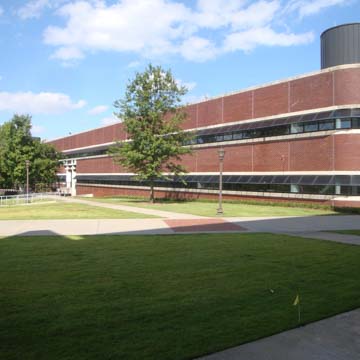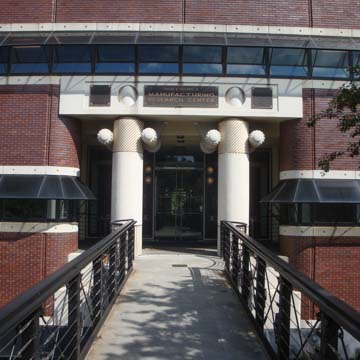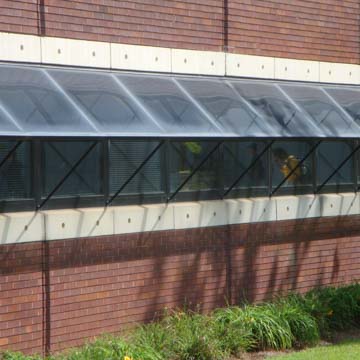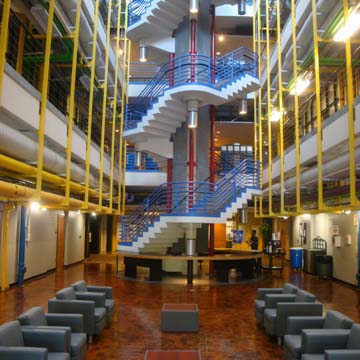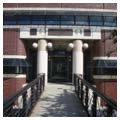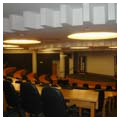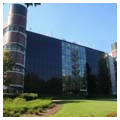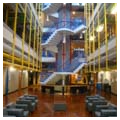You are here
Manufacturing Research Center
For Georgia Institute of Technology’s Manufacturing Research Center (MARC), Terry Sargent created a witty and smart design for a building intended to accommodate future demands and manufacturing research needs. The architect drew on precedents as widespread as Frank Lloyd Wright’s Johnson’s Wax Building (1936–1939), Stirling and Gowan’s Leicester Engineering Labs (1963), and the architectural group Archigram. Moreover, MARC’s transmogrification of classical elements to objects of modern technology and engineering present the building’s ornament as clever gestures of what Vitruvius called “delight” in architecture. Even prior to the building’s construction, its design was recognized nationally with a Progressive Architecture award.
In the 1950s, at the hand of Paul Heffernan of the firm of Bush-Brown, Gailey, and Heffernan, Georgia Tech’s campus was garnering praise as a pioneering work of modernist school architecture. While the campus continued to produce some noteworthy modern buildings during the 1960s and 1970s, there were few buildings by the mid-1980s that warranted national acclaim. MARC not only returned Georgia Tech’s architecture to a position of national reputation but also inaugurated the development of a new “west campus”: MARC would soon be joined by an array of stand-out architecture including Perkins and Will’s J. Erskine Love Building (1998–2000) and Stanley Love Stanley’s Aquatic Center (1993–1995, a joint venture with Smallwood, Reynolds, Stewart, Stewart and Associates), which developed into the Campus Recreation Center (2001–2004, Hastings and Chivetta).
The most pronounced formal feature of the MARC building is its long, low brick face with continuous ribbon windows and unbroken, slanted eyebrow shades. The fenestration defines an elevation of four levels at the north end; on the south end the building has a two-story elevation where it nestles into a hillside. The unrelenting continuity of horizontals and brick surfaces calls to mind Wright’s design for Johnson Wax, while the window treatment and end towers, monitor skylights, and steel bridges accessing the west and east entries call to mind British Brutalism’s honest, even raw, display of materials and structure.
Lord Aeck Sargent provides a theatrical sense in the orchestration of the visitor’s approach to the building and entry. The topography provides access, east and west, at the third-floor level, across a narrow angular bridge (catwalk) whose slight rise across a moat-like ravine penetrates the only substantial recess in the continuous plane of the building’s brick facade. This opening is treated like a classical loggia, defined by distyle in antis classical columns. On closer inspection, the Ionic order and surrounding details are formed out of cogs, gears, and rotatable cranes, images worthy of Archigram, the neo-futurist group active at the Architectural Association in London during the 1960s.
Indeed, MARC’s versatile spaces may well have found inspiration in another British High-Tech/neo-futurist project, Cedric Price’s Fun Palace of 1961. Although never built, Fun Palace influenced the architectural world of the late 1960s and 1970s, with its ideas early reflected in Richard Rogers and Renzo Piano’s Pompidou Center in Paris (1977). Dominant features and themes of Fun Palace were its inclusion of cutting-edge technology, its role as “anticipatory architecture,” and its large interior flexible space, the latter recalled in the high bay of MARC’s south end, where large equipment, vehicles, and machinery served a variety of campus research projects and activities. Principal Terry Sargent has acknowledged the ambiguity of the architectural program: as a research institution, Georgia Tech’s role in developing manufacturing solutions would require an adaptable space. The high bay, and ultimately a second facility (1995, Lord Aeck Sargent) would provide versatile spaces as well as dedicated laboratories for such research.
Even more directly influenced by British and French High-Tech projects is MARC’s multi-story atrium at the north end, with its brightly colored vents, ducts, and plumbing pipes, which recall those of the Pompidou Center. In contrast with the brickwork elsewhere, MARC’s north facade is glazed in dark gray glass, with ducts projecting beyond the building skin; behind is the brightly colored atrium within. An open, cast-concrete spiral staircase dominates the south end of the atrium, rising from ground to fourth floor with the ends of risers and treads forming a saw-toothed pattern cantilevered from a vertical shaft. Drain discharge pipes, hot and cold water supply pipes, heat ducts, chemical waste piping, and structural elements are all given distinctive colors (industrial paints in red, yellow, blue, and green).
All of these references at the Manufacturing Research Center are handled with assurance, avoiding a literal, overly derivative borrowing, while orchestrating a new masterwork, much as a musician creates “variations on a theme.” Paying homage to contemporary work allows Lord Aeck Sargent to extend that work at MARC, sometimes in response to the specific demands of the Georgia Tech campus site and to reflect its function as a college research building. At other times, the designer simply displays a whimsical turn, allowing a different reading, rather than a re-reading, of an historic usage. The playful High-Tech elements of the entry, for instance, is repeated in the auditorium, where huge cogs ornament the ceiling. These bring a sense of movement and energy in their curved edges with intersecting teeth, suggesting both rotation as well as the power of machinery, although here it remains stationary overhead. The image of technology abounds throughout MARC, evidenced in the building’s fenestration, ornament, structure, and systems. To the extent that there are overlays of neo-futurism here, the expression is highly appropriate as principal architect Sargent fulfills his charge both to design a building with non-specified program as well as to provide a structure that will address future research requirements, however they may evolve in the field of manufacturing.
References
Sargent, Terry. Interview Robert M. Craig, May 24, 1994.
Writing Credits
If SAH Archipedia has been useful to you, please consider supporting it.
SAH Archipedia tells the story of the United States through its buildings, landscapes, and cities. This freely available resource empowers the public with authoritative knowledge that deepens their understanding and appreciation of the built environment. But the Society of Architectural Historians, which created SAH Archipedia with University of Virginia Press, needs your support to maintain the high-caliber research, writing, photography, cartography, editing, design, and programming that make SAH Archipedia a trusted online resource available to all who value the history of place, heritage tourism, and learning.














